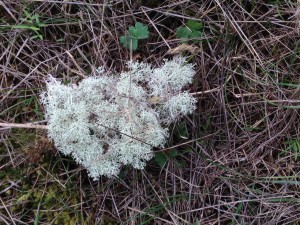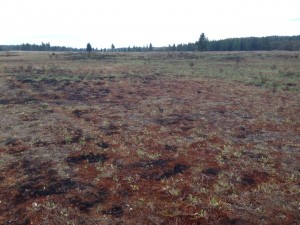Welcome to our blog on lichen restoration! We hope to educate people about lichens and what can be done to help conserve them. Lichens are a symbiotic relationship between a fungi, green algae and/or blue green algae, also known as cyanobacteria. The majority of the body, or what is called the thallus of the lichen, is made up by the fungal partner. The algae, also called the photobiont, performs photosynthesis giving the organism the energy it needs to survive(USDA Forest Service 2015).
Lichens are an extremely important part of every ecosystem they belong to. They are responsible for a large portion of the world’s carbon sequestering, which is vitally important pertaining to global climate change (PSY.ORG 2012). Cyanolichens are also nitrogen-fixers (PSY.ORG 2012). This means that cyanolichens can convert atmospheric nitrogen, N2, into nitrogen compounds that can be utilized by the cyanolichens and other organisms in the ecosystem. Lichens are also an indicator species. By studying the chemicals, pollution and nutrients that a lichen has in its composition, it can show what is prevalent in that area. This makes lichens great biomonitors (Blett, Porter 2003). Since lichens play such a significant role in their ecosystems, it is important to study and conserve their populations.
Mima Mounds
The Mima Mounds are a grassland environment with unique geological mound formations in the Pacific Northwest in Washington State. Many different species of lichens are found in that area, and there are some species that are now rare at Mima Mounds (Smith et. al. 2012). In particular the site is home to Cladonia spp. , also called reindeer lichen. At this location, the DNR performs prescribed burns that take
place in order to maintain a healthy ecosystem. The burns destroy invasive species and allows some species to reproduce by using fire. Although these burns help other organisms, it can destroy lichen populations. Lichens are very slow growing, so once they are destroyed in an area, it could take years for the same percent to return (Smith et. al. 2012). While at the moment there are no large scale restoration efforts for the rare species of the reindeer lichens, scientists are studying the Mima Mounds in order to understand more about the location, why they are important to the area, how to help the lichen species and why these species populations are decreasing.
Lichen on a Dish
Scientists and lichen enthusiasts have been trying to find ways to help the conservation of lichens. One possible way scientists have been studying and attempting to grow lichens are in labs. By taking samples of the species they want to grow and then placing them in petri dishes, sometimes in agar solution or a type of yeast nutrient broth(Hawksworth, Sangvichien, Whalley 2011). It takes months for the lichens to start to grow. It is difficult to grow lichens in a lab because different species require different nutrients and substrates. Also, the photobiont may not be able to be cultivated in a lab, while the fungal partner might. Some studies are also performed so that lichens can be cultivated in labs for pharmaceutical uses (Behera, Adawadkar, Makhija 2006).
Another technique that is being performed to help restore lichens is artificial dispersal. This is were samples of lichen species are spread or placed on a location or substrate where they want it to grow. One study performed by Marlene Lidén, was looking at boreal forests. They attached the lichen sample to the tree branch substrate and then attached it by a nylon thread, then a sheltering cocoon was placed over top of the branch. They found a high level of survival and growth for their samples (Liden et al. 2004). Another study found that when there was artificial dispersal in plots versus no artificial dispersal, increased species biomass in that plot was observed after 3 years (Faltynowicz, Studzinska-Sroka, Zarabska-Bozejewicz 2015).
Digging Deeper
While doing research, I started to wonder if the substrate acidity changed, would that hurt the lichen and overall lichen populations. For instance, with the prescribed fires, looking at before and after chemical composition of the soil in those areas. We know that pollutants can make a difference in the lichen populations, so a change in chemical composition of the soil or substrate should also be considered. A few studies I found that touched on this; one focused on how transplanting lichens to two different tree species, with two different pH, showed that the lichens had different chemical compositions after one year (Asplund, Gauslaa, Ohlson, 2015). Also, another study looked at how a increase of manganese (Mn) negatively impacted the reproductive structures, soredia, of the lichen (Paul, Hauck, Landgenfeld-Heyser 2004). I believe studies in chemical analysis relating to substrates could be extremely important to understanding how to restore lichen habitat.
Let’s Try to Grow them!
Im not sure how well this will work, but I think it would be a fun experiment to try out if your interested in attempting to grow lichens, so read up on Formula 29 (Magnificent Lichen Growth Formula) and see if it works ! http://lichenlovers.org/lichen_growth_formula.phtml
Whether you’re artificially dispersing lichens, growing them in a lab, or painting formula 29 on a rock, lichens are worth learning about and doing what you can to help conserve these awesome organisms!
Works Cited
“Algae, Lichens, and Mosses Take up Huge Amounts of Carbon Dioxide and Nitrogen from Atmosphere.” Algae, Lichens, and Mosses Take up Huge Amounts of Carbon Dioxide and Nitrogen from Atmosphere. PSY.ORG, 4 June 2012. Web. 12 Oct. 2015.
Asplund, J., M. Ohlson & Y. Gauslaa. Tree Species Shape the Elemental Composition in the Lichen Hypogymnia Physodes Transplanted to Pairs of Spruce and Beech Trunks. Fungal Ecology 16 (2015): 1-5.
Behera, B.c., B. Adawadkar & U. Makhija. Tissue-culture of Selected Species of the Graphis Lichen and Their Biological Activities. Fitoterapia 77.2 (2006): 208-15.
Blett, T. & E. Porter. Air Pollution- Related Lichen Monitoring in National Parks, Forest, and Refuges : Guidelines for Studies Intended for Regulatory and Management Purposes. (2003). U.S. Department of the Interior, U.S. Department of Agriculture.
Lidén M., M. Pettersson, U. Bergsten & T. Lundmark. Artificial Dispersal of Endangered Epiphytic Lichens: A Tool for Conservation in Boreal Forest Landscapes. Biological Conservation 118.4 (2004): 431-42.
“Magnificent Lichen Growth Formulas.” Magnificent Lichen Growth Formulas. <http://lichenlovers.org/lichen_growth_formula.phtml>.
Paul, A., M. Hauck & R. Langenfeld-Heyser. Ultrastructural Changes in Soredia of the Epiphytic Lichen Hypogymnia Physodes Cultivated with Manganese. Environmental and Experimental Botany 52.2 (2004): 139-47.
Sangvichien, E., D. I. Hawksworth & A. J.s. Whalley. Ascospore Discharge, Germination and Culture of Fungal Partners of Tropical Lichens, including the Use of a Novel Culture Technique. Imafungus IMA Fungus (2011): 143-53. PMC. U.S. National Library of Medicine.
Smith, R. J., Alphandary, E., Arvidson, R., Bono, G., Chipman, B., Corkery, A., DiMeglio, J., Hansen, K., Isch, K., McAlpine, J., Marks-Fire, C., Mead, B., Miller, D., Nolte, N., Ottombrino, A., Prior, T., Streich, J., Theis, S., Vandruff, Sc. Wessler, C., Wessler, K., Wiseman, M. and B. McCune. 2012. Rare inland reindeer lichens at Mima Mounds in Southwest Washington State. North American Fungi 7: 1-25.
What Are Lichens?.What Are Lichens?.USDA Forest Service.
Zarabska-Bożejewicz, D., E. Studzińska-Sroka & W. Fałtynowicz. Transplantation of Lichen Thalli: A Case Study on Cetraria Islandica for Conservation and Pharmaceutical Purposes. Fungal Ecology 16 (2015): 34-43.




Recent Comments